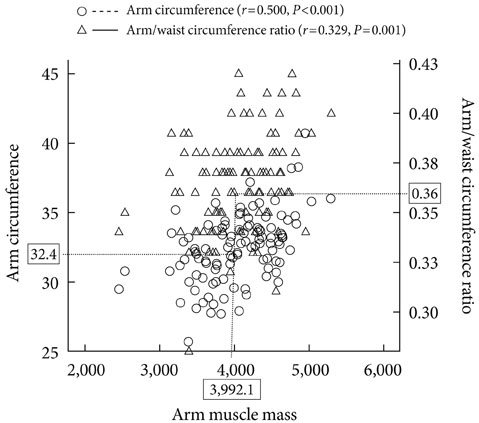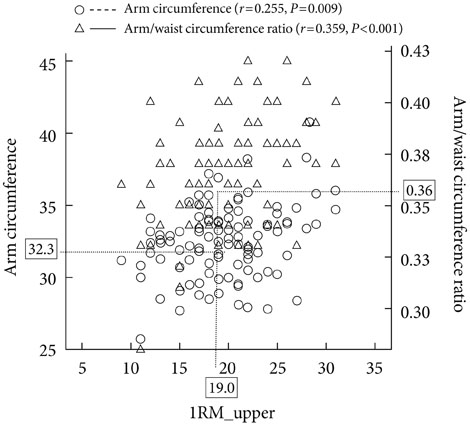Diabetes Metab J.
2011 Aug;35(4):374-383. 10.4093/dmj.2011.35.4.374.
The Correlations between Extremity Circumferences with Total and Regional Amounts of Skeletal Muscle and Muscle Strength in Obese Women with Type 2 Diabetes
- Affiliations
-
- 1Diabetes Center, Eulji Hospital, Seoul, Korea.
- 2Department of Internal Medicine, Eulji University School of Medicine, Seoul, Korea. minyungwa@gmail.com
- KMID: 2281644
- DOI: http://doi.org/10.4093/dmj.2011.35.4.374
Abstract
- BACKGROUND
Insulin resistance is related to central obesity and the amount of skeletal muscle. A simple and practical anthropometric marker for muscle mass is not known, although waist circumference (WC) is used as an indicator of abdominal obesity. The aims of this study were to investigate whether arm (AC) and thigh circumferences (TC) can be used as an indicator of muscle mass and if they are related to muscle strength.
METHODS
A total of 110 obese (body mass index [BMI]> or =25 kg/m2) women with type 2 diabetes were enrolled, and WC, AC, and TC were measured. Abdominal visceral fat (AVF), subcutaneous fat (ASF), and total fat (ATF) were assessed by computed tomography, regional muscle (MM), and fat mass by dual-energy X-ray absorptiometry, muscle strength by one repetition maximum (1RM) of both extremities (chest and leg press) and insulin resistance by KITT.
RESULTS
The mean age was 56.2+/-7.3 years, duration of diabetes was 4.2+/-4.4 years, and BMI was 27.2+/-2.8 kg/m2. WC was correlated with ATF, AVF, and ASF (r=0.728, P<0.001; r=0.515, P<0.001; r=0.608, P<0.001, respectively). Arm MM was correlated with AC (r=0.500, P<0.001), and leg MM with TC (r=0.291, P=0.002). Upper 1RM was related to AC/WC ratio (r=0.359, P<0.001), and lower 1RM was to TC/WC ratio (r=0.286, P=0.003). Insulin resistance had significant relations with AVF, WC, and total MM (r=-0.262, P=0.008; r=-0.217, P=0.029; r=0.160, P=0.031, respectively).
CONCLUSION
The muscle mass was related to extremity circumferences, and muscle strength was to extremity/waist circumference ratio in obese women with type 2 diabetes.
MeSH Terms
Figure
Reference
-
1. McKeigue PM, Marmot MG, Adelstein AM, Hunt SP, Shipley MJ, Butler SM, Riemersma RA, Turner PR. Diet and risk factors for coronary heart disease in Asians in northwest London. Lancet. 1985. 2:1086–1090.2. Molarius A, Seidell JC. Selection of anthropometric indicators for classification of abdominal fatness: a critical review. Int J Obes Relat Metab Disord. 1998. 22:719–727.3. Cheng YJ, Gregg EW, De Rekeneire N, Williams DE, Imperatore G, Caspersen CJ, Kahn HS. Muscle-strengthening activity and its association with insulin sensitivity. Diabetes Care. 2007. 30:2264–2270.4. Dunstan DW, Daly RM, Owen N, Jolley D, De Courten M, Shaw J, Zimmet P. High-intensity resistance training improves glycemic control in older patients with type 2 diabetes. Diabetes Care. 2002. 25:1729–1736.5. Epidemiologic and methodologic problems in determining nutritional status of older persons. Proceedings of a conference. Albuquerque, New Mexico, October 19-21, 1988. Am J Clin Nutr. 1989. 50:5 Suppl. 1121–1235.6. Sigal RJ, Kenny GP, Wasserman DH, Castaneda-Sceppa C. Physical activity/exercise and type 2 diabetes. Diabetes Care. 2004. 27:2518–2539.7. Cha BS, Won YJ, Lee JH, Nam SY, Song YD, Lee EJ, Lim SK, Kim KR, Lee HC, Huh KB, Shin MJ, Lee JH. The correlation between insulin resistance and the visceral fat vs. skeletal muscle ratio in middle-aged women. J Korean Diabetes Assoc. 1996. 20:395–409.8. American College of Sports Medicine. ACSM's Guidelines for exercise testing and prescription. 2006. 7th ed. Philadelphia: Lippincott Williams & Wilkins;58–60.9. Bonora E, Moghetti P, Zancanaro C, Cigolini M, Querena M, Cacciatori V, Corgnati A, Muggeo M. Estimates of in vivo insulin action in man: comparison of insulin tolerance tests with euglycemic and hyperglycemic glucose clamp studies. J Clin Endocrinol Metab. 1989. 68:374–378.10. Baechle TR, Earle RW. Essentials of strength training and conditioning. 2000. 2nd ed. Champaign: Human Kinetics.11. Smith SR, Lovejoy JC, Greenway F, Ryan D, deJonge L, de la Bretonne J, Volafova J, Bray GA. Contributions of total body fat, abdominal subcutaneous adipose tissue compartments, and visceral adipose tissue to the metabolic complications of obesity. Metabolism. 2001. 50:425–435.12. Alberti KG, Eckel RH, Grundy SM, Zimmet PZ, Cleeman JI, Donato KA, Fruchart JC, James WP, Loria CM, Smith SC Jr. International Diabetes Federation Task Force on Epidemiology and Prevention. Hational Heart, Lung, and Blood Institute. American Heart Association. World Heart Federation. International Atherosclerosis Society. International Association for the Study of Obesity. Harmonizing the metabolic syndrome: a joint interim statement of the International Diabetes Federation Task Force on Epidemiology and Prevention; National Heart, Lung, and Blood Institute; American Heart Association; World Heart Federation; International Atherosclerosis Society; and International Association for the Study of Obesity. Circulation. 2009. 120:1640–1645.13. Lee S, Park HS, Kim SM, Kwon HS, Kim DY, Kim DJ, Cho GJ, Han JH, Kim SR, Park CY, Oh SJ, Lee CB, Kim KS, Oh SW, Kim YS, Choi WH, Yoo HJ. Cut-off points of waist circumference for defining abdominal obesity in the Korean population. Korean J Obes. 2006. 15:1–9.14. Jung ED, Chung DS, Lee JY. The correlation between visceral fat distance measured by ultrasonography and visceral fat amount by computed tomography in type 2 diabetes. Korean Diabetes J. 2008. 32:418–427.15. Kwon HR, Ku YH, Ahn HJ, Jeong JY, Ryu SR, Koo BK, Han KA, Min KW. Maximal muscle strength deteriorates with age in subjects with type 2 diabetes mellitus. Korean Diabetes J. 2009. 33:412–420.16. An KH. Effect of low intensity circuit-type resistance training on glycemic control, insulin resistance and lipid profile in type 2 diabetics. J Korea Sport Res. 2005. 16:113–122.17. Zhu S, Wang Z, Heshka S, Heo M, Faith MS, Heymsfield SB. Waist circumference and obesity-associated risk factors among whites in the third National Health and Nutrition Examination Survey: clinical action thresholds. Am J Clin Nutr. 2002. 76:743–749.18. Kim TH, Kim DJ, Lim S, Jeong IK, Son HS, Chung CH, Koh G, Lee DH, Won KC, Park JH, Park TS, Ahn J, Kim J, Park KG, Ko SH, Ahn YB, Lee I. Prevalence of the metabolic syndrome in type 2 diabetic patients. Korean Diabetes J. 2009. 33:40–47.19. Pouliot MC, Despres JP, Nadeau A, Tremblay A, Moorjani S, Lupien PJ, Theriault G, Bouchard C. Associations between regional body fat distribution, fasting plasma free fatty acid levels and glucose tolerance in premenopausal women. Int J Obes. 1990. 14:293–302.20. Randle PJ, Garland PB, Newsholme EA, Hales CN. The glucose fatty acid cycle in obesity and maturity onset diabetes mellitus. Ann N Y Acad Sci. 1965. 131:324–333.21. Miyazaki Y, Glass L, Triplitt C, Wajcberg E, Mandarino LJ, De-Fronzo RA. Abdominal fat distribution and peripheral and hepatic insulin resistance in type 2 diabetes mellitus. Am J Physiol Endocrinol Metab. 2002. 283:E1135–E1143.22. Baron AD, Brechtel G. Insulin differentially regulates systemic and skeletal muscle vascular resistance. Am J Physiol. 1993. 265(1 Pt 1):E61–E67.23. Kim D, Nam S, Ahn C, Kim K, Yoon S, Kim J, Cha B, Lim S, Kim K, Lee H, Huh K. Correlation between midthigh low-density muscle and insulin resistance in obese nondiabetic patients in Korea. Diabetes Care. 2003. 26:1825–1830.24. Heymsfield SB, McManus C, Smith J, Stevens V, Nixon DW. Anthropometric measurement of muscle mass: revised equations for calculating bone-free arm muscle area. Am J Clin Nutr. 1982. 36:680–690.25. Kwon HR, Han KA, Ku YH, Ahn HJ, Koo BK, Min KW. Relationship of maximal muscle strength with body mass index and aerobics capacity in type 2 diabetic patients. Korean Diabetes J. 2009. 33:511–517.26. Kim MK. The change of muscle mass and distribution by dual energy X-ray absorptiometry according to age and gender in Korean adults. J Sport Leis Stud. 2004. 22:357–368.27. Chung JE, Hwang SJ, Kim MJ, Song JY, Cho HH, Kwon DJ, Lew YO, Lim YT, Kim EJ, Kim JH, Kim JH, Kim MR. Relationship between body composition and bone mineral density in pre- and post-menopausal women. J Korean Soc Menopause. 2010. 16:29–38.28. Shin HK, Lee SH, Tae KS. The correlation between 1RM and MVC for estimating strength. J Korea Sport Res. 2003. 14:409–414.29. An KH, Min KW, Han KA. The effects of aerobic training versus resistance training in non-obese type 2 diabetics. J Korean Diabetes Assoc. 2005. 29:486–494.30. Han JY, Lee MG, Sung SC. Effects of combined training of rope skipping and walking on body composition, physical fitness, blood lipids, and insulin resistance in middle-aged women. Korean J Sport Sci. 2009. 20:199–211.31. Ahn N, Kim K. Comparisons of 12 week combined exercise intervention-mediated changes of body composition, physical fitness, and metabolic syndrome risk factors according to IGF-I gene polymorphism in obese adolescent boys. Korean J Obes. 2009. 18:102–115.32. Mathiowetz V, Kashman N, Volland G, Weber K, Dowe M, Rogers S. Grip and pinch strength: normative data for adults. Arch Phys Med Rehabil. 1985. 66:69–74.33. Kim KB, Hong KD, Lee DC, Lee SW, Jun TW. Estimation of one repetition maximum by anthropometric measurements in weight training beginners. Exerc Sci. 2005. 14:495–504.
- Full Text Links
- Actions
-
Cited
- CITED
-
- Close
- Share
- Similar articles
-
- The Effects of Aerobic/Resistance Exercise on Body Fat Mass, Muscle Strength and Endothelial Function in Korean Type 2 Diabetes mellitus Patients
- Amount of Daily Protein Intake Is Not Associated with Skeletal Muscle Strength in Older Adults
- Effect of Troglitazone on Glycogen synthase Activity in Human skeletal Muscle Culture from Obese Non-Diabetic and Obese Non-insulin Dependent Diabetes Mellitus
- Relationship Between Respiratory Muscle Strength and Conventional Sarcopenic Indices in Young Adults: A Preliminary Study
- Assessment of Muscle Quantity, Quality and Function



